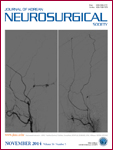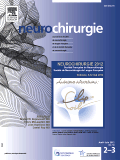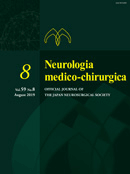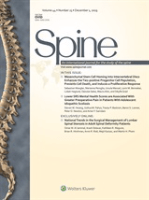
Journal of Korean Neurosurgical Society
Scope & Guideline
Elevating Neuroscience: Knowledge for a Brighter Future
Introduction
Aims and Scopes
- Clinical Neurosurgery:
The journal extensively covers clinical practices in neurosurgery, including surgical techniques, case studies, and outcomes related to various neurosurgical procedures. - Neurocritical Care:
Research focusing on the management and treatment of critically ill neurological patients is a significant aspect, particularly concerning traumatic brain injuries and cerebrovascular diseases. - Neurosurgical Innovations:
The journal emphasizes innovative techniques and technologies in neurosurgery, such as robotic-assisted surgeries, minimally invasive techniques, and the application of artificial intelligence. - Pediatric Neurosurgery:
A dedicated focus on pediatric cases, including congenital malformations and interventions for pediatric neurological disorders, highlighting the unique challenges in this demographic. - Neuro-oncology:
Research articles on brain tumors, including surgical treatments and outcomes, as well as advancements in radiotherapy and chemotherapy for brain malignancies. - Vascular Neurosurgery:
The journal covers vascular conditions affecting the brain and spine, including aneurysms and arteriovenous malformations, focusing on both surgical and endovascular approaches.
Trending and Emerging
- Artificial Intelligence in Neurosurgery:
There is a growing interest in the application of artificial intelligence for enhancing surgical outcomes, diagnostic accuracy, and patient management protocols. - Telemedicine and Remote Patient Management:
The COVID-19 pandemic has accelerated the adoption of telemedicine, with increasing research on its efficacy in neurosurgical practice and remote management of patients. - Neuroprotective Strategies Post-Surgery:
Emerging studies focus on neuroprotective agents and strategies aimed at improving recovery and outcomes in patients following neurosurgical interventions. - Endovascular Techniques:
A significant uptick in research related to endovascular procedures for treating vascular neurosurgical conditions, reflecting a shift towards less invasive treatment options. - Pediatric Neurosurgical Innovations:
Increased focus on novel approaches and techniques specifically tailored for pediatric patients, addressing unique anatomical and physiological considerations.
Declining or Waning
- Traditional Neurosurgical Techniques:
There appears to be a decreasing emphasis on traditional, open surgical techniques, as newer minimally invasive approaches and technologies gain prominence. - Basic Neuroscience Research:
While foundational neuroscience research is essential, there has been a noticeable decline in articles focusing solely on basic science, as the journal shifts towards more clinically applicable research. - Radiological Studies without Clinical Correlation:
Studies that primarily focus on radiological findings without a strong clinical application or implication are becoming less common, as the journal favors research that connects imaging with patient outcomes.
Similar Journals

CANADIAN JOURNAL OF NEUROLOGICAL SCIENCES
Nurturing the Future of Neurological ScienceCanadian Journal of Neurological Sciences, published by Cambridge University Press, stands as a reputable source of knowledge in the field of neurology, dedicated to advancing research and clinical practice. With an ISSN of 0317-1671 and an E-ISSN of 2057-0155, this journal has been a cornerstone for the exchange of ideas since its inception in 1974 and will continue to cater to the academic community until 2024. Recognized in the top quartile (Q2) in various categories including Medicine (miscellaneous) and Neurology (clinical), its articles engage a broad audience, ranging from established researchers to students seeking to deepen their understanding of neurological sciences. Although the journal is not an open-access publication, it provides vital insights and research findings that contribute significantly to its fields. With a Scopus rank of #183 in clinical neurology and a percentile ranking that reflects its commendable standing, the Canadian Journal of Neurological Sciences is indispensable for those committed to the exploration and treatment of neurological disorders.

NEUROSURGERY
Advancing the Frontier of Neurosurgery.NEUROSURGERY, published by Lippincott Williams & Wilkins, stands as a foremost journal in the field of clinical neurology and surgery, reflecting a commitment to advancing knowledge and practice through high-quality research and discourse. With an impact factor indicative of its scholarly significance and a remarkable Scopus ranking placing it in the Q1 category for both neurology and surgery, this journal provides a vital platform for clinicians, researchers, and students to explore cutting-edge developments and innovations. NEUROSURGERY publishes peer-reviewed articles that span the spectrum of neurosurgical practice, from basic science discoveries to clinical applications, fostering a collaborative exchange of ideas and methodologies. Since its inception in 1977, the journal has maintained a focus on delivering substantive research that informs practice and enhances patient care, making it an essential resource for professionals dedicated to the fields of neurology and surgery. The journal is based in India, and while it currently does not offer open access options, its rich archive from 1977 to 2024 ensures a comprehensive repository of knowledge for those engaged in this critical area of medicine.

PEDIATRIC NEUROSURGERY
Transforming Insights into Impactful Neurosurgical SolutionsPediatric Neurosurgery is a vital academic journal dedicated to the exploration and advancement of neurosurgical practices in pediatric populations. Published by Karger in Switzerland, this journal spans a rich history dating back to its inception in 1955, with continuous contributions enhancing our understanding of child neurosurgery up to 2024. With an ISSN of 1016-2291 and an E-ISSN of 1423-0305, it currently holds a reputable position in the Q3 quartile for various medical categories, including Medicine (miscellaneous), Neurology (clinical), and Pediatrics. Despite its lack of Open Access options, this journal serves as a critical resource for researchers, clinicians, and students engaged in pediatric neurosurgery, offering insightful studies, groundbreaking clinical practices, and the latest advancements in the field. As the journal continues to develop and explore new methodologies, it remains an essential platform for disseminating significant findings that shape the future of pediatric neuroscience.

Operative Neurosurgery
Fostering Knowledge to Shape the Future of Operative Techniques.Operative Neurosurgery is a distinguished peer-reviewed journal published by Lippincott Williams & Wilkins, focusing on the rapidly evolving fields of neurology and surgery. With an ISSN of 2332-4252 and an E-ISSN of 2332-4260, this journal serves as a vital platform for disseminating high-quality research, clinical studies, and innovative practices from 2012 through 2024. As of 2023, it holds a reputable position in category quartiles—Q3 in clinical neurology and Q2 in surgery—demonstrating its commitment to contributing to the scientific community. The journal's placement in the Scopus rankings also reflects its significance, with a ranking of #177 out of 551 in surgery and #229 out of 400 in clinical neurology. Although it operates under a traditional subscription model, the journal remains dedicated to enhancing access to pivotal information that shapes operative techniques and patient outcomes, making it an essential resource for researchers, surgeons, and clinicians alike. Through rigorous peer review and a commitment to academic integrity, Operative Neurosurgery invites contributions that advance knowledge and foster further exploration within these crucial fields.

BRITISH JOURNAL OF NEUROSURGERY
Bridging science and surgery for improved patient outcomes.Welcome to the British Journal of Neurosurgery, a premier interdisciplinary publication dedicated to advancing the field of neurosurgery and enhancing clinical practice. Published by Taylor & Francis Ltd, this esteemed journal features a rich repository of peer-reviewed research covering innovative methodologies, case studies, and evidence-based practices across neurology and surgery. With an ISSN of 0268-8697 and an E-ISSN of 1360-046X, the journal is indexed in notable databases, reflecting a commendable standing in academia, categorized in Q2 for Surgery and Q3 for Medicine and Clinical Neurology as of 2023. Although currently not offering Open Access, the British Journal of Neurosurgery retains a readership of researchers, clinicians, and students eager for the latest insights impacting patient outcomes and surgical techniques. With an aim to bridge scientific inquiry and practical application, this journal plays an essential role in the global neurosurgical community, making significant contributions from its base in the United Kingdom.

SURGERY
Elevating surgical practices through comprehensive reviews.SURGERY, an esteemed journal published by MOSBY-ELSEVIER, stands at the forefront of medical literature in the field of surgical practices and innovations. With a rich history dating back to its inception in 1937, this journal has consistently provided cutting-edge research and comprehensive reviews aimed at enhancing surgical outcomes and techniques. It proudly holds a prestigious Q1 classification in Surgery as per the 2023 category quartiles, ranking #68 out of 551 in the Scopus database, placing it in the top 87th percentile within its category. This makes SURGERY an essential resource for researchers, practitioners, and students alike, providing valuable insights and advancements that shape surgical methodologies around the globe. Although it is not an open-access journal, its authoritative content and accessibility through institutional subscriptions ensure that the latest surgical research is available to scholars and healthcare professionals. Engage with a community dedicated to excellence in surgical science and practice through SURGERY, where every article contributes to the progression of medical knowledge and patient care.

Neurochirurgie
Innovating Surgical Practices for TomorrowNeurochirurgie, published by MASSON EDITEUR, stands as a prominent peer-reviewed journal in the fields of neurology and surgery, reflecting its commitment to advancing clinical practices and surgical innovations. With an impressive history dating back to 1955 and a convergence period extending to 2024, this journal serves a vital role in disseminating comprehensive research and updates relevant to both medical practitioners and researchers. Neurochirurgie holds a respectable Q3 ranking in clinical neurology and a Q2 ranking in surgery as of 2023, positioning it within the upper echelons of medical journals; its Scopus rankings further underline its growing influence, particularly in the surgical domain. Despite its non-open access model, the journal offers a platform where high-quality, rigorously vetted studies can be accessed, fostering an environment of knowledge exchange that is essential for the ongoing development of neurosurgical practices. For researchers, professionals, and students alike, Neurochirurgie presents an invaluable resource for staying at the forefront of neurological research and surgical advancements.

NEUROLOGIA MEDICO-CHIRURGICA
Bridging Disciplines for Innovative Medical InsightsNEUROLOGIA MEDICO-CHIRURGICA, published by the JAPAN NEUROSURGICAL SOCIETY, stands as a vital resource in the fields of neurology and surgery, featuring an impressive track record since its inception in 1959. With both an ISSN 0470-8105 and E-ISSN 1349-8029, this journal has embraced an Open Access model since 2000, ensuring that cutting-edge research and clinical advances are readily accessible to a global audience. The journal is currently ranked in the Q2 quartile for Neurology (clinical) and the prestigious Q1 quartile for Surgery as of 2023, highlighting its impact within these disciplines. With Scopus rankings placing it at #145 in Surgery and #206 in Neurology, NEUROLOGIA MEDICO-CHIRURGICA continues to play a crucial role in advancing medical knowledge, making it an indispensable reference for researchers, clinicians, and students alike. The journal's broad scope encompasses both clinical neurology and surgical techniques, positioning it at the forefront of interdisciplinary collaboration in the ever-evolving field of neurosurgery.

SPINE
Pioneering research for a healthier spine.SPINE, published by Lippincott Williams & Wilkins, is a leading academic journal in the fields of Orthopedics, Neurology, and Sports Medicine. Established in 1976, this reputable journal has made significant contributions to advancing clinical and scientific knowledge, with its impactful research evidenced by its prestigious Q1 classification across three essential categories in 2023 and a notable ranking of #51 in Orthopedics and Sports Medicine and #117 in Clinical Neurology as per Scopus. SPINE aims to disseminate high-quality research articles, reviews, and clinical studies that address cutting-edge topics and challenges in spine-related health, thereby serving as an invaluable resource for researchers, healthcare professionals, and students alike. With its commitment to rigorous peer review and a wide readership, SPINE continues to be at the forefront of innovations in spine health & disease from 1976 to 2024, upholding its reputation as a catalyst for progress in the medical community.

Egyptian Journal of Neurosurgery
Exploring New Frontiers in Neurosurgical ExcellenceWelcome to the Egyptian Journal of Neurosurgery, a leading publication in the field of neurosurgery, meticulously curated by SPRINGERNATURE. With an E-ISSN of 2520-8225, this journal has been committed to advancing the understanding of neurosurgical practices since embracing Open Access in 2018, ensuring widespread accessibility of groundbreaking research and clinical insights. Based in London, England, at CAMPUS, 4 CRINAN ST, LONDON N1 9XW, the journal aims to bridge gaps in neuroscience research, providing a platform for innovative studies, systematic reviews, and case reports. By publishing high-quality, peer-reviewed articles, the Egyptian Journal of Neurosurgery aims to equip researchers, professionals, and students with the knowledge and tools necessary to enhance patient care and outcomes in neurosurgical practices globally. Join our vibrant community of scholars dedicated to exploring the complexities of the brain and spine, and contribute to the evolving narrative of neurosurgery.